5 Plants That Held Our Ancestors
A Conversation with Bioregional Rootworker, Asia Dorsey on Black Herbal Wisdom
Hello, beautiful people! I’m honored to share a project I recently worked on through my role as Marketing & Ecological Storyteller with Ecoversity. In reverence of Juneteenth, I had the privilege of sitting down with two Black herbalists whose words felt like a homecoming for me. Through our conversations, I found myself tracing connections between the plants they honored and the foods I grew up eating, but never knew the full stories behind.
Today, I’m sharing the second part of that story: A conversation on ancestral medicine with Bioregional Rootworker Asia Dorsey. As a gift, Asia is offering free access to her powerful mini-course: Red Drank: A Hibiscus Liberation Journey, a deep dive into ancestral plant medicine, African diasporic wisdom, and the medicine that lives in our kitchens. You’ll find the link below.
When I got on a call with Asia Dorsey, I was in my journalist mindset. I had a few questions prepared, but truthfully, I didn’t know where the conversation would land. I was trying to feel where the conversation wanted to go.
So I asked:
What plants could we tell the story of Juneteenth through?
What did enslaved Africans carry and forage?
What medicine helped them survive?
From there, the conversation bloomed into one of the most expansive and grounding exchanges I’ve ever experienced. We talked about history, healing, and ancestral wisdom. Everything I’m sharing with you today grew from that moment.
Asia is such a gracious, deeply knowledgeable herbalist—a bioregional rootworker with years of experience tracing the lineage of plants and their role in our collective healing. She speaks of land and liberation in the same breath.
These are the plants she shared. The medicine our ancestors used to survive and care for each other through the generations:

Mullein (Verbascum thapsus)
Mullein holds the memory of the lungs. Used in African American rootwork, this bright yellow-flowered plant supports posture, breath, and resilience. It moves down the spine and into the chest, helping us stand tall, speak clearly, and breathe through grief. In places where environmental racism left many Black children, especially girls, with asthma, mullein helped the community breathe easier and reclaim their strength.

Black Walnut (Juglans nigra)
In the harsh conditions of enslavement, parasites were a daily reality. Black walnut, with its juglone and tannins, was used to help expel them. Enslaved people learned about its antiparasitic power from Indigenous allies. Over generations, Black families infused this bitter medicine into sweet traditions like black walnut ice cream, blending healing with cultural memory.

Okra (Abelmoschus esculentus)
Okra, with its slippery mucilage, soothes the body from mouth to womb. African midwives gave it to pregnant women to ease labor, and cooks drew out its slime to help the body release heat and toxins. Whether in stews, gumbo, or drawing soups, okra’s cooling, moistening qualities helped Black communities stay well and move through heat, grief, and hardship with grace.

Cotton (Gossypium)
Cotton’s history is complex. Enslaved people were forced to grow it, yet its root offered a secret form of power. Used to regulate menstruation or end unwanted pregnancies, cotton root gave Black women a way to reclaim agency over their bodies. It’s a symbol of reproductive justice, reminding us that even in oppression, there were tools of choice, care, and resistance.
Hibiscus (Hibiscus sabdariffa)

Hibiscus traveled with enslaved people from West Africa to the Caribbean and the Americas, where it became the base for beloved drinks like sorrel and agua de Jamaica. Rich in chromium and selenium, hibiscus supports heart health and blood sugar balance. Across the diaspora, it is a plant of joy, celebration, and resistance, offering a sweet-tart taste of embodied liberation.
These are just a few of the plants that remember us.
They carried our ancestors. They still carry us.
Their medicine is woven into our food, our stories, our resistance, and our joy.
I’d love to know what ancestral foods, herbs, or healing traditions live in your lineage?
Let’s keep remembering, together.
🪴 Until next time, be well,
- Lee




